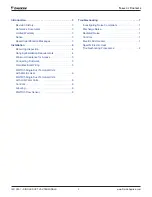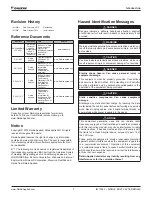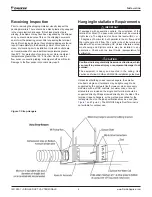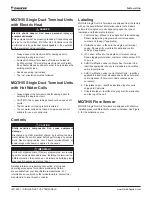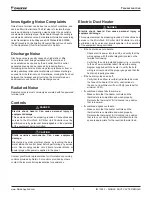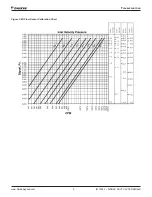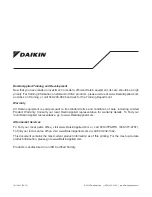
T
roubleshooTIng
www.DaikinApplied.com
7
IM 1093-1 • SINGLE DUCT VAV TERMINALS
T
roubleshooTIng
Investigating Noise Complaints
Noise from a terminal can be due to a variety of conditions, and
can be difficult to eliminate. The first step is to isolate the type,
source and direction. Generally, noise heard at the air outlet is
considered a discharge type. Noise heard through the ceiling is
considered a radiated noise. For detailed information concerning
noise transmission in buildings see ARI Standard 885-2008E,
titled
Procedure For Estimating Occupied Space Sound Levels
In The Application Of Air Terminals and Air Outlets.
Discharge Noise
Discharge noise is usually caused by high static or little
to no internal duct lining downstream of the terminal. It
can sometimes be caused by the air outlet itself. Air outlet
generated sounds can be reduced by reducing flow or
increasing air outlet size. Reducing static pressure, or flow, or
adding additional attenuation materials will reduce discharge
sounds from the terminal unit. Sometimes, moving the flex duct
between the terminal and air outlet so the air must make an
additional turn will help with the discharge sound.
Radiated Noise
Radiated noise is most commonly associated with fan powered
terminal units.
Controls
DANGER
Electric shock hazard . Can cause personal injury or
equipment damage .
This equipment must be properly grounded. Connections and
service to the MicroTech III Chiller Unit Controller must be
performed only by personnel knowledgeable in the operation
of the equipment being controlled.
CAUTION
Static sensitive components . Can cause equipment
damage .
Discharge any static electrical charge by touching the bare
metal inside the control panel before performing any service
work. Never unplug cables, circuit board terminal blocks, or
power plugs while power is applied to the panel.
Contact your Daikin representative for information concerning
controls provided by Daikin. For controls provided by others,
contact the local control representative for assistance.
Electric Duct Heater
DANGER
Electric shock hazard . Can cause personal injury or
equipment damage .
This equipment must be properly grounded. Connections and
service to the MicroTech III Chiller Unit Controller must be
performed only by personnel knowledgeable in the operation
of the equipment being controlled.
• If the heater does not operate:
—
Check electric power into the unit, and verify that the
wiring agrees with the label diagram located on the
terminal unit casing.
—
Verify that the unit is installed properly (i.e., according
to the air flow orientation label). Review the wiring
diagram supplied with the heater to verify the field
wiring is correct and of the proper gauge and that the
heater is properly grounded.
• If the heater cycles on and off:
—
Verify that the airflow is uniformly distributed across
the face of the heater. Check for obstructions in
the duct, or insufficient air flow (CFM) (see label for
minimum CFM).
• If conditioned space fails to warm-up:
—
Make certain that the heater controls and the
thermostat are compatible and wired properly.
Relocate the thermostat if it is located in a position
that is too warm.
• If conditioned space overheats:
—
Make certain that the heater controls and the
thermostat are compatible and wired properly.
Relocate the thermostat if it is located in a position
that is too cool. Verify that the air distribution to the
space is appropriate for the required thermal load.


